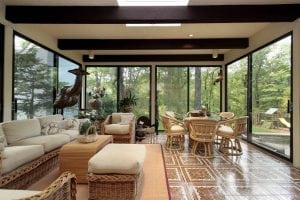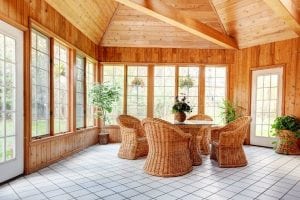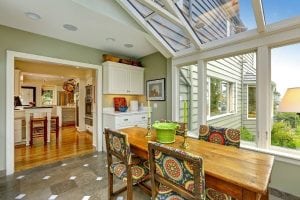There’s been a recent increase in suburban homeowners building a sunroom addition—for both aesthetic and atmospheric reasons. It looks fresh, and luxurious, and it can no doubt brighten any area. Adding a sunroom to your home is a major decision that requires careful planning and, as a homeowner, it’s your job to oversee the entire installation process from beginning to end.
Planning your sunroom addition can be taxing but ultimately rewarding—especially once you see the outcome. To start you off, here’s a comprehensive to-do list to effectively prepare for the sunroom ideas you’ve been dreaming of.
Contents
1. Inspect Your Property

An Indoor Average Size of Sunroom
Before entertaining thoughts of installation, you need to know if you can install it. That means inspecting your property for potential locations that can accommodate the sunroom sizes—usually ranging between 10’ x 12’ and 16’ x 24’. Typically, a sunroom addition is installed on the first floor of the home, near the kitchen or lounge, for optimal sunlight use during the day.
The average sunroom size will depend on a number of factors. For instance; the minimum and a maximum number of people you estimate will occupy the area at once, how much existing space you have for the room itself, and your local area’s building requirements.
Some cities have different parameters regarding permitted development structures. For example, it can’t be higher than the existing roof, it does not have an attached balcony or veranda, it does not extend beyond 6m … and so on. It would be best to call the right departments to learn your area’s specific building requirements.
Also consider the view. While the sunlight can be rewarding enough, it can be a bit of a downer if you end up looking at a brick wall outside your window instead of a beautifully manicured garden or yard.
2. Outline Financial Considerations
Right away, you can expect to shell out a significant amount of money for your sunroom. However, sunroom addition costs are probably not as costly as you’re expecting. Although a sunroom addition installation can be pricey, it’s a sound investment that promises to improve your home’s atmosphere and your property’s market value. Having that sunroom may be just the refreshing change of pace you and your family needs.
3. Check Permits
While the prospect of finally having a sunroom addition can be exciting, don’t forget that you need to meet all standard legal requirements, like permits and zoning considerations. For example, you’ll need to secure installation licenses and follow building codes. You can ask your local government for assistance in finding and securing all requirements. The home remodeling contractors you hire for the job should also be quite knowledgeable regarding this, and may be able to help you, too.
4. Consider Home Temperatures

An Outdoor Sunroom
If you’re simply planning for an open, disconnected sunroom, you won’t have to worry about any heating or cooling concerns. However, if you’re planning to set up an indoor sunroom, you should consider extending your heating and cooling system to regulate temperatures. This could come off as a little costly, so it depends hugely on what you want and what’s in your budget.
5. Decide whether it’s Three-Season or Year-Round
Having a year-round sunroom can be more expensive than a three-season sunroom due to the need for extended heating (as mentioned in the previous section). Your climate will play an important role in deciding this. For locations with generally cooler climates, vents and ceiling fans may suffice during the summer. You may also improve the heating through thermal windows or an electric baseboard heater. Otherwise, you’ll have to extend your home’s existing HVAC.
6. Use Complimentary Designs
While room additions can be an opportunity to flex your creativity, it’s important that you keep the design in harmony with your home’s existing architecture and interior. The sunroom’s flooring, furniture, and layout should complement and blend smoothly with the rest of the home.
7. Consider the Type of Sunroom
You can choose between two types: a prefab sunroom addition or a site-built sunroom.
sunroom addition are made offsite. They’re then dismantled and sent to your home to be put back together with minimal fuss and effort. This type helps save time and expenses. However, design options are very limited.
A site-built sunroom, on the other hand, is built on the premises. It’s a little costlier, but it offers unlimited design possibilities. With this option, you can choose your floorings, windows, roofing, furniture, and layout.
Read These 4 Things to Consider Before a Home Addition Remodel!
8. Contact Your Trusted Contractor
Make sure you contact a reliable contractor for your project. They must have proven expertise in the field and must meet legal requirements for their individual professional as a business entity. After you’ve contacted them, you may then show them your plans and discuss them as extensively as necessary. Make reconsiderations and amendments wherever possible, as per their advice.
After the consultation, they should be able to give you an estimate for the sunroom addition.
Planning for your sunroom additions will demand time and other resources. It’s best to cover as many grounds as you can to avoid or minimize delays—at least on your end. Make this project a one-off and plan ahead to enjoy that sunroom in no time at all. In the end, all the preparation and planning will be worth it. You have the perfect place for a breakfast nook, a place to sip your morning coffee in peace, or even unwind after a long day while stargazing. You finally have the sunroom addition design plans of your dreams.

Recent Comments